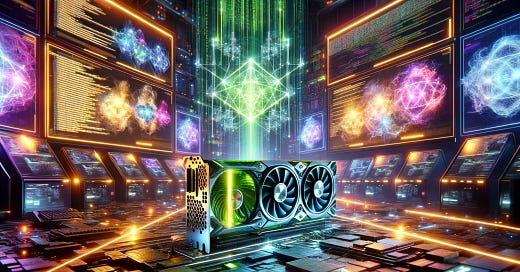NVIDIA’s GTC in Four Headlines
Impressive AI hardware innovations and interesting software moves.
Next Week in The Sequence:
Edge 381: We start a new series about autonomous agents! We introdice the main concepts in agents and review the AGENTS framework from ETH Zurich. Additionally, we provide an overview of BabyAGI.
Edge 382: We review PromptBreeder, Google Deemind’s self-improving prompt technique.
You can subscribe below:
📝 Editorial: NVIDIA’s GTC in Four Headlines
I tried to resist making this weekend's editorial about NVIDIA because I think you might have been inundated with headlines from the GTC conference. Unable to resist, I instead decided to present the four most impactful announcements in terms of ambition and market impact. If I have to summarize two key takeaways from NVIDIA's AI announcements this week, they would be these:
NVIDIA is not only outgrowing but also out-innovating everyone else in AI compute hardware by a large margin.
NVIDIA's software ambitions should be taken seriously.
To put that in context, here are four key announcements from this week's GTC:
Blackwell GPU Series: NVIDIA unveiled the Blackwell B200 GPU, optimized for trillion-parameter models. The chip can improve LLM inference by up to 30x, which is quite remarkable.
NIM Microservices: My favorite announcement of GTC was the NIM platform, which delivers models optimized for inference and packaged as containers. NIM speeds up inference by using the Triton Inference Server, TensorRT, and TensorRT-LLM.
Project GR00T: I think the coolest and most ambitious announcement was Project GR00T, which focuses on developing foundation models for humanoid robots. The stack is based on multimodal models for video, audio, and language.
Distribution: An overlooked announcement during GTC was the impressive list of strategic alliances with top software companies like Microsoft, Google, Amazon, Dell, Oracle, and many others. NVIDIA is simply everywhere.
There were many additional announcements at GTC, but the aforementioned four are incredibly impactful. NVIDIA's AI hardware dominance is unquestionable, but it's quickly making inroads in the software space.
🔎 ML Research
Chronos
Amazon Science published a paper introducing Chronos, a family of pretrained foundation models for time series forecasting. Chronos models time-series data using the same techniques used by LLMs —> Read more.
Moirai
Salesforce Research also got into time series forecasting with foundation models with the publication of a paper detailing Moirai. The new model follows the paradigm of a universal forecasting model that can issues predictions across many domains and time scales —> Read more.
TacticAI
Google DeepMind published a paper detailing TacticAI, a model that can provide technical insights in football( soccer) plays, particularly corner kicks. The model uses geometric deep learning by generating possible reflections of a game situation including the player’s relationships —> Read more.
RAFT
Researcers from UC Berkely published a paper introducing retrieval-augmented fine-tuning(RAFT), a training technique that improves the ability of models to answer questions based on external data. Given a question, RAFT ignores the documents that are not relevant to formulagte the answer leading to more accurate outputs —> Read more.
Evolutionary Optimization and FM Model Merging
Researchers from Sakana AI published a paper that uses evolutionary optimization to merge foundation models. The technique attempts to harness the collective intelligence of different models to create more powerful foundation models —> Read more.
SceneScript
Meta AI Research published a paper detailing SceneScript, a method for reconstructing layouts of physical spaces. The technique can have profound implications in augmented reality scenarios that merge physical and virtual spaces —> Read more.
🤖 Cool AI Tech Releases
NVIDIA NIM
NVIDIA announced NIM, its cloud microservices endpoints for pretrained foundation models —> Read more.
Grok
Elon Musk’s xAI open sourced a version of its marque model Grok —> Read more.
Stable Video 3D
Stability AI released Stable Video 3D, an improved model that can generate 3D objects from text descriptions —> Read more.
🛠 Real World ML
AI Training Logging at Meta
Meta discusses Logarithm, their solution for AI training logging —> Read more.
GNNs at Pinterest
Pinterest details their use of graph neural networks(GNNs) for content understanding —> Read more.
RL at Lyft
Lyft discusses the architecture powering their internal reinforcement learning workloads —> Read more.
Cloud Monitoring at Microsoft
Microsoft discusses the AI used to monitor its Azure cloud services —> Read more.
📡AI Radar
NVIDIA unveiled plenty of AI hardware and software innovations at its GTC conference.
Reddit had a strong IPO debut fueled by AI data demands.
Apple is reportedly in conversations with Google to power IPhone AI features using Gemini.
On a surprising move, Microsoft hired Inflection co-founder Mustafa Suleyman and part of his team to lead its Copilot efforts.
After loosing several key people, Inflection announced a pivot into AI for business.
NVIDIA announced a series of AI partnerships with the world’s largest tech companies.
Databricks announced the acquisition of Lilac to improves its unstructure data preparation and analysis capabilities.
Astera Labs shares popped 70% in its IPO pushed by the demand of its AI data transfer features.
Roblox introduced new AI features for Avatar creation and texturing.
Anthropic, AWS and Accenture announced a strategic alliance to bring generative AI to enterprises.
ServiceNow released a new version of its Now platform for AI workflow automation.
Amazon and Snowflake announced a partnership to modernize data streaming pipelines.



